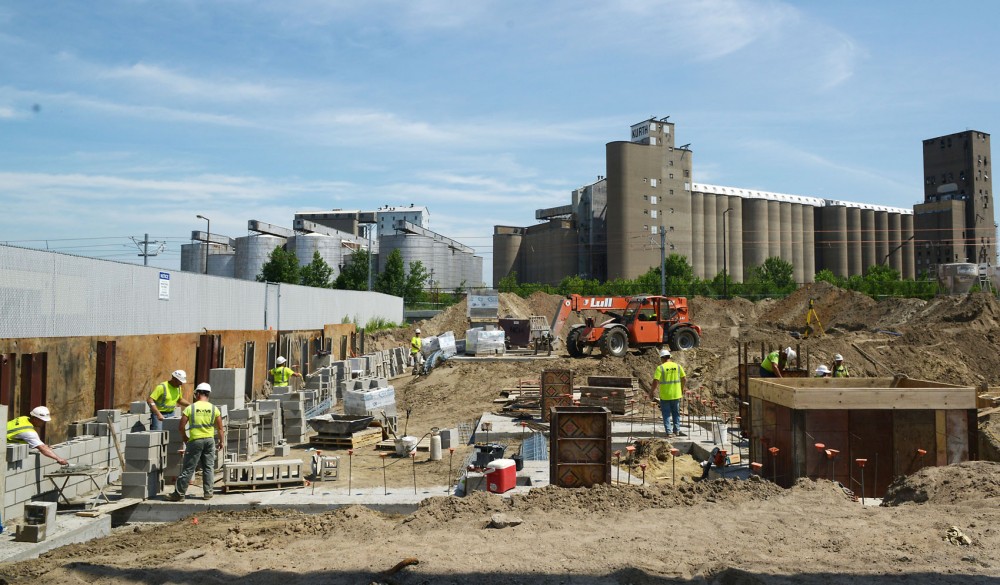Prospect Park officials, business owners and residents all agree the Central Corridor light-rail line will change the neighborhood when construction finishes next year.
But they don’t agree on how the neighborhood should deal with it.
Members of Prospect Park 2020, a nonprofit organization created in March, hope to bring new businesses and affordable housing to the neighborhood. They want to avoid the large student apartment complexes that have dominated new construction in Marcy-Holmes, where members say the demand is already being met.
“We have no opposition to student housing,” said 2020 board member Dick Gilyard. “But we’d like to nudge that closer to campus.”
Gilyard said the group is looking for developers who match their vision for the neighborhood rather than reacting to proposals on a case-by-case basis.
“We’re pretty confident that the area was going to develop with or without us,” he said.
A market research report the organization commissioned last year predicted that Prospect Park could handle adding 75,000 square feet of retail space and nearly 2,000 housing units in the next 16 years.
“This is a decade-long effort, at least,” Gilyard said.
Colleen Carey, president of The Cornerstone Group, said her development company has been working with Prospect Park 2020 for two years, when they were a smaller neighborhood group.
She said the neighborhood is “one of the greatest development opportunities along the new light-rail line.”
The Cornerstone Group plans to develop a 200-unit housing complex near the corner of 29th Avenue Southeast and Fourth Street Southeast, Carey said. While students could live there, she said, it won’t be geared toward them.
“We think there are enough other student housing options being developed,” Carey said. “Our interest is in creating more of a community that has a wider range of housing options.”
Sources: The City of Minneapolis, Lupe Development, Marcy-Holmes Neighborhood Association, Prospect Park East River Road Association, Cornerstone Group, Dinkytown Rentals, Doran Companies, Hupp Holdings, CPM Property Management
Students want more housing
While Prospect Park 2020 board members have said they want to avoid an increase in student housing, some University of Minnesota students said it’s what the neighborhood needs.
Health and wellness senior Andy Aldrich lives just east of Prospect Park. He said he likes the area because it’s safe and “very welcoming.”
Though he said his rent is affordable, Aldrich said he would like to see more student housing in the neighborhood.
“For being so close to the University of Minnesota,” he said, “it’s disappointing to see [a lack of student housing].”
Computer science senior Jungwoo Jang said more housing for students would be good if it drove rent prices down.
“This neighborhood is
nice,” he said, “but right now, it’s too expensive.”
Bringing in business
One of Prospect Park 2020’s main goals is attracting more businesses to the neighborhood.
The organization has been collaborating with the Textile Center, a business located on the edge of the neighborhood, to expand its space and attract other arts-based businesses to the area.
Steering committee member Tom Tierney owns Tierney Brothers, Inc., an audiovisual company near the Witch’s Hat water tower. Tierney said he probably won’t benefit from light-rail traffic because he does mostly business-to-business sales. But new businesses in the area could be potential customers.
Other property owners are wary of setting a plan for the neighborhood’s future in stone.
Prospect Park 2020 is “creating an atmosphere where developers are interested in the neighborhood,” said Jeff Barnhart, property manager with Prospect Park Properties, which owns four retail buildings in the area. But market demand should drive development, he said.
Several developers have approached Prospect Park Properties to buy their land on University Avenue Southeast, Barnhart said.
“A lot of people call us,” he said. “A lot of people want to talk.”
Barnhart said he supports what 2020 is doing, but he and his father are worried that a single vision for the neighborhood might restrict them if they ever decide to sell or develop their property.
“If people go too far down one path with one vision,” he said, “that could be a limiting approach.”








